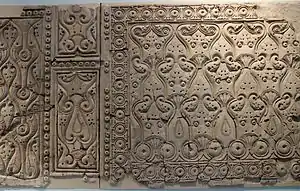Arabesque
Arabesque is an artistic decoration. It uses "surface decorations based on... interlacing foliage, tendrils" or plain lines.[1] Another definition is "Foliate ornament, used in the Islamic world, typically using leaves... combined with spiralling stems".[2]

Stone relief with arabesques in the Umayyad Mosque, Damascus

Border decoration to an Ottoman miniature, early 16th century
Arabesques are usually of a single design which can be 'tiled' or repeated as many times as desired.[3]
The term "arabesque" is used as a technical term by art historians for decoration in Islamic art from about the 9th century onwards, and European decorative art from the Renaissance onwards. Note that Islamic geometric patterns are a different style from arabesques.
References
- Fleming, John & Honour, Hugh 1977 (1989). Dictionary of the decorative arts. Penguin. ISBN 978-0-670-82047-4.
{{cite book}}: CS1 maint: multiple names: authors list (link) CS1 maint: numeric names: authors list (link) - Rawson, Jessica 1984. Chinese ornament: the lotus and the dragon. British Museum Publications, p236. ISBN 0-7141-1431-6
- Robinson, Francis 1996 (2002). The Cambridge illustrated history of the Islamic world. Cambridge University Press. ISBN 978-0-521-66993-1.
{{cite book}}: CS1 maint: numeric names: authors list (link)
This article is issued from Wikipedia. The text is licensed under Creative Commons - Attribution - Sharealike. Additional terms may apply for the media files.
